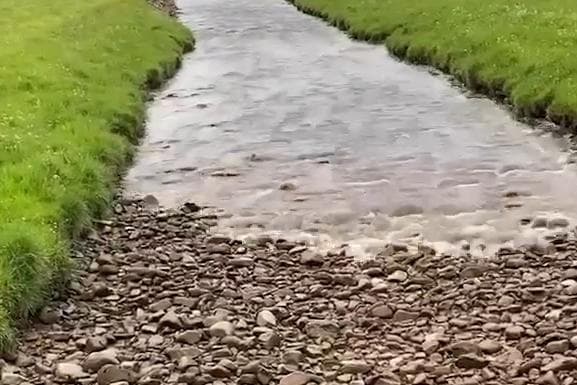You are using an out of date browser. It may not display this or other websites correctly.
You should upgrade or use an alternative browser.
You should upgrade or use an alternative browser.
Kingsdale bore
- Thread starter Pitlamp
- Start date
Babyhagrid
Well-known member
Here's the original https://www.instagram.com/reel/CeVeBJ0KV9o/?igshid=YmM0MjE2YWMzOA==
Also here for those who don't us Instagram

 www.yorkshirepost.co.uk
www.yorkshirepost.co.uk
Also here for those who don't us Instagram

Watch stream in Yorkshire Dales turn into fast-flowing river in just minutes
This is the remarkable moment a dry stream slowly fills up to transform into a fast-flowing river in a matter of minutes.
Babyhagrid
Well-known member
not sure who the author is but hopefully someone from RRCPC can shed some light on the original account.
cap n chris
Well-known member
Thankfully we don't have to deal with "proper" nature, here, like they do in foreign parts:
cap n chris
Well-known member
On this general topic, and thinking it might be of benefit to a wider audience, I routinely used to include this link/footage of the consequences of a flood pulse (aka flash flood) on my cave leadership training courses. Make of it what you will. On Mendip "some water is fun; more water is funner" but that's because the catchments there are pathetic; increase the catchment(s) by orders of magnitude and life-threatening consequences can be literally minutes away. Food for thought.
cap n chris
Well-known member
A forum pendant can provide more accurate details but if memory serves Swildon's Hole catchment is around the 168ha mark, whereas Longwood/August is 212ha; and that compares with Porth-yr-Ogof at 5,400ha, and Easegill of 7,200ha. This is purely off the top of my head and may be significantly out; accurate figures warmly welcomed. Remember kids: white water rapids aren't rapid (turbulent flow is slower than laminar deep water flow - check out Manning's Equation). Deep water is the silent killer but white water is the stuff you can't float in (cos it doesn't have buoyancy-giving density; if it's bubbling, you instantly sink in it); never ceases to amaze me that people need to be told this.
Last edited:
Pitlamp
Well-known member
I have seen the River Manifold do that.
Thanks; I heard that can happen but I never had the opportunity to witness that one. Is Lathkilldale another example?
Just to clarify; the reason I posted this topic is because I'm interested in intermittent streams in limestone areas, where normal flows are underground in cave systems but floods cause rivers to flow on the surface (as opposed to "ordinary" dry stream beds that can flash flood alarmingly fast in convectional rainfall events).
Does anyone know of any other examples of the former, in the UK?
cap n chris
Well-known member
There is an occasional river flowing out of Withyhill towards Hilliers on the surface when the cave is in flood. I have not seen it for myself but many have and the surface erosion attests to it.
langcliffe
Well-known member
It seems that the rivers Dee and Skirfare should qualify.
langcliffe
Well-known member
And, of course, the Nidd.
danthecavingman
Member
Cressbrook Dale flows on the surface in flood. Top end of Chapel-Le-Dale as well.Thanks; I heard that can happen but I never had the opportunity to witness that one. Is Lathkilldale another example?
Just to clarify; the reason I posted this topic is because I'm interested in intermittent streams in limestone areas, where normal flows are underground in cave systems but floods cause rivers to flow on the surface (as opposed to "ordinary" dry stream beds that can flash flood alarmingly fast in convectional rainfall events).
Does anyone know of any other examples of the former, in the UK?
Brains
Well-known member
There is some footage somewhere of Sleets Gill becoming a resurgence and flowing down the intermittent dry valley below it. I believe in this state of flood the cave is full. There was a rescue with divers to retrieve dry cavers trapped beyond a flood sump that didnt completely fill the system
wellyjen
Well-known member
It's towards the end of the Sid Perou film Hard Decisions at Sleets Gill, about the 1992 rescue when the dry cavers were dived out.There is some footage somewhere of Sleets Gill becoming a resurgence and flowing down the intermittent dry valley below it. I believe in this state of flood the cave is full. There was a rescue with divers to retrieve dry cavers trapped beyond a flood sump that didnt completely fill the system
andybrooks
Member
I think this would be the case for all three Welsh rivers: Nedd Fechan, Mellte, and Hepste.Thanks; I heard that can happen but I never had the opportunity to witness that one. Is Lathkilldale another example?
Just to clarify; the reason I posted this topic is because I'm interested in intermittent streams in limestone areas, where normal flows are underground in cave systems but floods cause rivers to flow on the surface (as opposed to "ordinary" dry stream beds that can flash flood alarmingly fast in convectional rainfall events).
Does anyone know of any other examples of the former, in the UK?
Brains
Well-known member
https://ukcaving.com/board/index.php?threads/sleets-gill-cave-flooding-details.12687/post-164064
The video from 2011 in this link is what I was originally thinking of, and shows the Sleets Gill cave becoming quite a powerful resurgence. Impressive
The video from 2011 in this link is what I was originally thinking of, and shows the Sleets Gill cave becoming quite a powerful resurgence. Impressive



